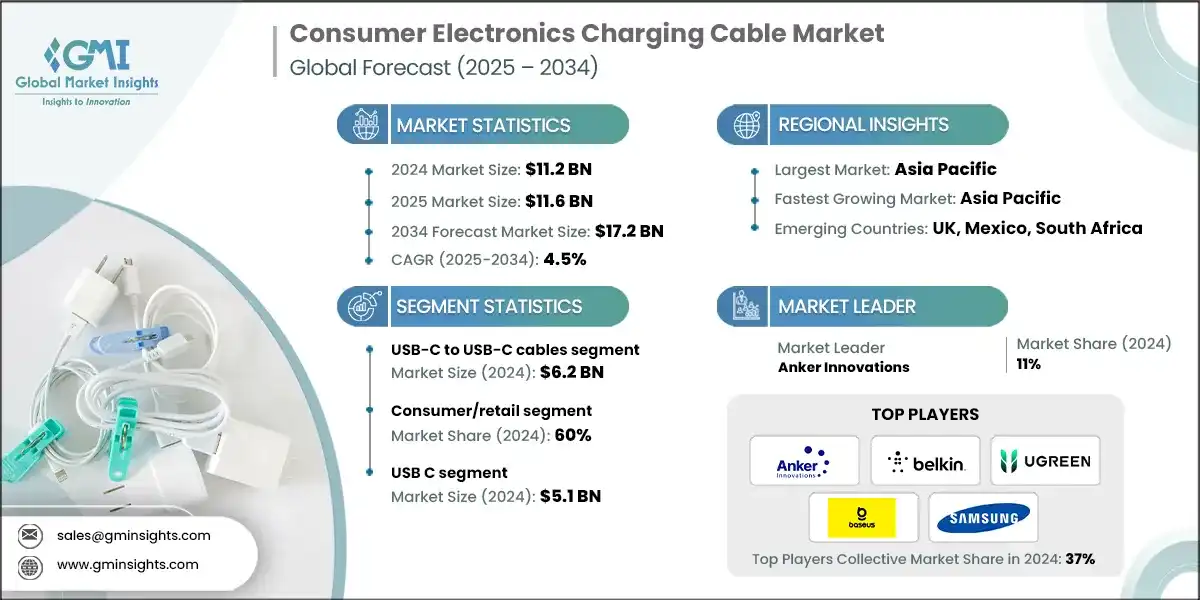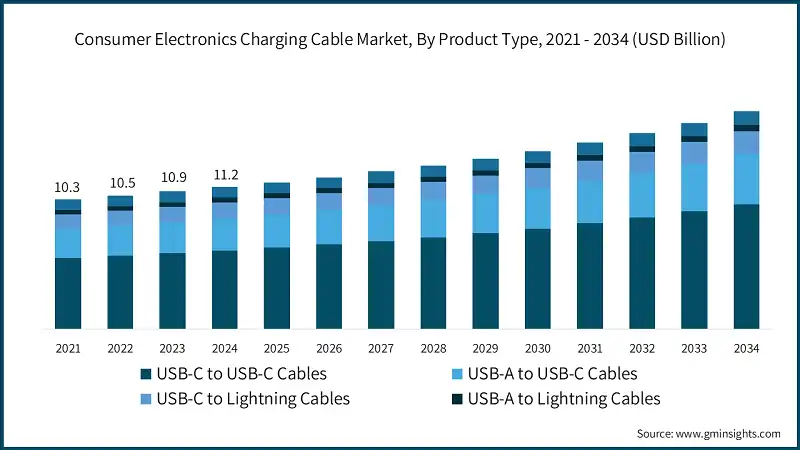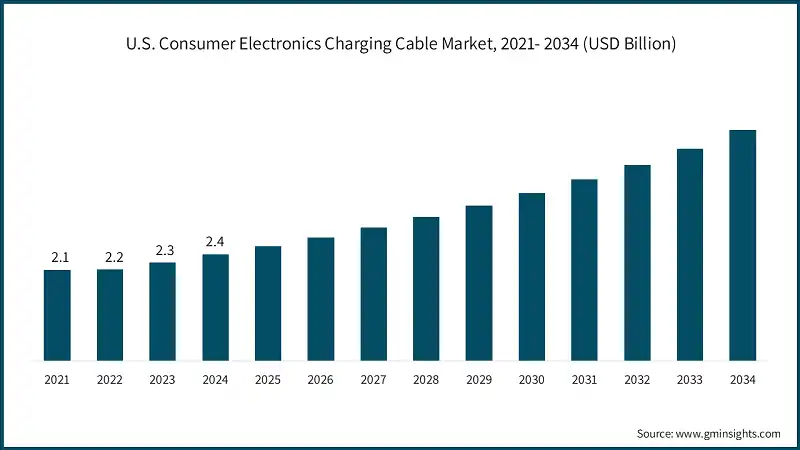Consumer Electronics Charging Cable Market Size, Share

Consumer Electronics Charging Cable Market Size
The global consumer electronics charging cable market size was estimated at USD 11.2 billion in 2024. The market is expected to grow from USD 11.6 billion in 2025 to USD 17.2 billion in 2034, at a CAGR of 4.5% according to latest report published by Global Market Insights Inc.

To get key market trends
Download Free PDF
The market for charging cables in the consumer electronics sector is rapidly evolving under the influence of people increasingly using smart devices such as smartphones, tablets, laptops and wearables. People now expect fast, durable and multifunction charging options, and manufacturers are constantly innovating with new appealing features like braided exteriors, strengthened connectors and USB-C options to meet those demands. The current societal movement toward more environmentally friendly product design has an influence on charging cable designs, more brands are using recyclable materials and reducing waste by removing packaging and reducing unnecessary accessories.
In response to consumers being frustrated with products that often do not last very long and finding themselves with a lot of cables, manufacturers in the industry are introducing multifunction charging cables and offering warranties. Areas with high smartphone market share, like Asia-Pacific and North America, display strong demand everywhere and we see emerging markets quickly catching up. The rise of e-commerce influences consumer, purchasing behavior with online reviews and influencer preferences have become an important consideration for consumers and marketers. This highlights how convenience and smart purchasing behavior is becoming much more prevalent in the market.
The market has transitioned from more of utilitarian purpose to more of a user experience, convenience and value, with sustainable products still being added to the overall experience when it meets their needs. As we move forward with improving technology, charging cables will be redesigned to meet new expected standards and integrating them, as always, as a key pillar of the consumer electronics experience.
Consumer Electronics Charging Cable Market Report Attributes
| Key Takeaway | Details |
|---|---|
| Market Size & Growth | |
| Base Year | 2024 |
| Market Size in 2024 | USD 11.2 Billion |
| Market Size in 2025 | USD 11.6 Billion |
| Forecast Period 2025 – 2034 CAGR | 4.5% |
| Market Size in 2034 | USD 17.2 Billion |
| Key Market Trends | |
| Drivers | Impact |
| Expansion of connected device ecosystem | As smartphones, tablets, and wearables continue to grow in popularity, demand for cables will also increase. |
| Acceleration in fast charging technology adoption | Due to fast charging becoming a market need, charging cables will develop further in performance and user experience. |
| Widespread USB-C standardization across devices | Consumers require universal cables because of increased compatibility. |
| Pitfalls & Challenges | Impact |
| Limited durability and frequent cable failures | Non-durable products will create complaints and have a buy, use, and toss, mentality. |
| Market saturation with counterfeit and low-quality products | Counterfeit cables can be a safety issue and diminish consumers trust in brand |
| Opportunities: | Impact |
| Development of eco-friendly and recyclable cable solutions | The sustainability movement can contribute to opening your platform to innovative green products. |
| Integration of smart features in charging cables | Value-added features (LED indicators, data-sync abilities, etc.) that enhance utility and user experience while providing an additional premium factor to the product. |
| Market Leaders (2024) | |
| Market Leaders |
11% market share |
| Top Players |
The collective market share in 2024 is 37% |
| Competitive Edge |
|
| Regional Insights | |
| Largest market | Asia Pacific |
| Fastest growing market | Asia Pacific |
| Emerging countries | UK, Mexico, South Africa |
| Future outlook |
|
What are the growth opportunities in this market?
Download Free PDF
Consumer Electronics Charging Cable Market Trends
The market is changing quickly due to user demand for faster, more rugged and versatile cables, given the increased number of devices that they own. USB-C and other fast charging features will soon be typical. Sustainable materials and packaging still have relevance. Although the move to wireless charging is firmly underway, consumers will still want cables for data transfer, speed and quick charging capabilities. In general, the market seems to be merging performance, convenience and sustainability into the modern tech lifestyle.
- USB-C and USB-C Power Delivery technology now have a power capacity of 240W, meaning that devices such as gaming laptops and high-performance electronics are capable of quick charging without long downtime. With the ability to charge power devices quickly, consumer productivity increases.
- Material Improvements and Durability: The protective material improvements such as nylon braiding, TPE, PVC, and Kevlar reinforcement allow manufacturers extra freedom with a cable’s durability. Key trends have pointed to increased durability and tangle-resistant cables of any variety for consumers, whether for casual, connected, business, or anywhere in between.
- USB-C Standardization: The implementation of the Common Charger Directive from the European Union has ushered in a rapid transition to USB-C, being the dominant standard charging port for electronic devices. Standardization benefits decreasing e-waste, conveniences for consumers, and a single reversible connector to connect devices easily.
- New cable options are hitting the market with signs of technology advancing with smart features, such as indicators for charge level, data protection, and charging chips. Future options may provide new flexibility in how modern devices charge through an integration with AI for the advancement of technology.
- Current trends for consumer preference are leaning toward companies producing batteries using more sustainable alternatives. Once again, trends are changing the market with companies that are producing charges out of recycled, biodegradable, and plant-based products. Companies producing sustainable alternatives is additionally reinforced as international business, with consumer demand for more environmentally friendly alternatives.
Consumer Electronics Charging Cable Market Analysis

Learn more about the key segments shaping this market
Download Free PDF
Based on product type, the market is divided into USB-C to USB-C cables, USB-A to USB-C cables, USB-C to lightning cables, USB-A to lightning cables, and micro-USB cables. In 2024, USB-C to USB-C cables held the major market share, generating a revenue of USD 6.2 billion.
- USB-C to USB-C cables dominate the market, a trend developed with the most recent shift to standardized USB-C plug and terminal connections worldwide. This transition was partly driven by regulations but also in part because of the vast technical superiority of USB-C protocols for bidirectional power delivery, fast transfer speeds for data exchange, and capabilities to support video output. Some of the market tailwinds for this segment can be attributed to the growing adoption of USB-C across devices, such as smartphones, laptops, tablets, and other peripherals. In addition to the shift to USB-C functionality across devices, regulatory initiatives in the European Union, India, and other parts of the world are accelerating demand for USB-C to USB-C solutions.
- USB-A to USB-C cables still represent transitional solutions for consumers using older USB-A infrastructure. These cable solutions offer consumers a variety of ways to increase compatibility across devices, as they allow connections from older chargers, power banks, and computer and laptop ports to USB-C powered devices. Cables from USB-A to USB-C should continue to fulfill a purpose even after Brexit, as consumers upgrade charging systems while retaining older USB-A nation-state connections.
- USB-C to Lightning cables is the bulk of the market for Apple users needing to connect Lightning, albeit this segment will have more long-term challenges presented by modernization regulations to USB-C adoption. This provides the market simply serves to support existing iPhone and iPad users while development and modernization regulations change the segment. There is a positive sign the market is in transition, as Apple integrates USB-C across its product lines, while technology companies and developers maintain development support of prior legacy devices with functionality, even after future modernization regulations go into effect.

Learn more about the key segments shaping this market
Download Free PDF
Based on end user, the consumer electronics charging cable market is segmented into single layer and multi-layers. The consumer/retail segment held the largest share, accounting for 60% of the global market in 2024.
- The consumer/retail segment remains the leading market segment, driven by a combination of greater smartphone adoption, consumer electronics, and the growing availability of charging infrastructure. The consumer/retail segment is composed, in total, of consumer electronics, retail, and aftermarket replacement demand on multiple devices, such as smartphones, tablets, laptops, gaming devices, and audio accessories.
- The increase in consumers choosing premium, durable, and fast charging cables coupled with shorter replacement cycles – supports this growth. The transition to USB-C is supporting consumer demand as it increases compatibility and connection options across devices and is an attractive pathway to meet regulatory requirements for compliance and charging requirements.
- In the automotive segment, the expansion of USB-C connectivity in vehicle infotainment systems, charging systems, and vehicle passenger connectivity, is a principal driver of growth. Newer vehicles, beyond consumer applications, rely on offering multiple USB-C ports for charging, data transfer, and media connectivity, which is driving the need for automotive cables that also have durability and temperature specifications for automotive applications.
- Healthcare is an emerging growth segment, as the reliance on a host of cables that connect multiple medical devices and patient monitoring equipment – accompanied by the charging infrastructure inside healthcare organizations – is steady growth factor. Healthcare is unique in its need for cables that meet safety and reliability requirements, and its cable cannot only need to meet medical device accessory regulations, a cable or connector may also be part of a critical healthcare application.
Based on the connector type, the consumer electronics charging cable market is segmented into USB C, lightning, micro-USB, and proprietary. In 2024, USB C held a major market share, generating a revenue of USD 5.1 billion.
- USB-C is becoming the dominant connector type due to its standardized universal applicability and advanced technical features and it is likely to continue leading the driver in connector types by virtue of being reversible, delivering enhanced power, and offering multi-purpose connectivity for consumers and manufacturers alike. Regulatory imposed convergence combined with market demand for simplified connectivity is likely to see further acceleration of USB-C margins.
- Lightning connectors remain relevant largely because of their use within the Apple ecosystem. Even though pressures continue to emerge (both from regulators and consumers) regarding USB-C, Lightning continues to serve a function in the iPhone-centric areas because of Apple’s existing installed user base and ecosystem.
- Micro-USB is still relevant particularly in price sensitive areas and end-of-life devices. Even though it relates to being shadowed out by USB-C in premium application use systems, it is still a relatively economical device and accessories alternative. There are still use-cases were low-cost trumps capacity and enhancements.
- In some cases, proprietary connectors are useful for narrow-use cases where they provide a unique solution as an advantage for narrow area usage.

Looking for region specific data?
Download Free PDF
North America Consumer Electronics Charging Cable Market
In 2024, the U.S. dominated the North America market, accounting for around 74.7% and generating around USD 2.4 billion revenue in the same year.
- North America holds significant consumer demand for electronics. The consumer will pay a premium for the top-tier products, and North America is fastest to adopt new charging technologies, emphasizing its continued leadership.
- In the United States, consumers will show a significant interest in fast-charging products, cables that multi-charge devices, and high-end accessories to support various ecosystems. Overall, these attributes continue to reinforce the region’s role as a driver for growth and innovation in addressing consumer interests.
Europe Consumer Electronics Charging Cable Market
Europe market, Germany leads the market with 25.38% share in 2024 and is expected to grow at 4.5% during the forecast period.
- In Europe, the market path is dictated almost entirely by regulatory developments. Although these developments can be seen as a catalyst that leads many countries to adopt the USB-C standard and promote faster replacement cycles.
- All the regulatory work puts growth in the market and overall consumer satisfaction, drives standardization, saves consumers money, and creates less electronic waste. Europe has consistently led the way in accountability, sustainability in actions specifically aligned to the region’s environmental and economic goals showing its commitment to developing a fairer, more equitable market for the region.
Asia Pacific Consumer Electronics Charging Cable Market
The Asia Pacific leads the market, China holds a market share of around 29% in 2024 and is anticipated to grow with a CAGR of around 5.3% from 2025 to 2034.
- The Asia Pacific is the largest and fastest growing market, driven by its large consumer electronics production capacity, high smartphone penetration, and rapid adoption of new charging technologies.
- Specifically, China, India, Japan, and South Korea are the core contributors of this growth on the back of significant domestic demand and an export-driven manufacturing base. The region continues to show its ability to adapt to new technology and has a well-established production infrastructure, which puts it firmly in a leading market position.
- India is becoming increasingly important as the growth driver due to various regulatory positions and domestic manufacturing policy changes. The government’s directive for USB-C adoption, plus incentives under the Production Linked Incentive (PLI) initiative, will create additional opportunities for the players in the market. Plus, with the growing smartphone sector and more consumer electronics adoption in the country, this will lead to an increase in demand for charging cables.
Consumer Electronics Charging Cable Market Share
Anker Innovations is leading with 11% market share. Anker Innovations, Belkin International, UGREEN, Baseus, and Samsung Electronics collectively hold around 37%, indicating moderately fragmented market concentration. These prominent players are proactively involved in strategic endeavors, such as mergers & acquisitions, facility expansions & collaborations, to expand their product portfolios, extend their reach to a broad customer base, and strengthen their market position.
- Anker Innovations produces charging cables, power banks, and adapters which sustains its position as a leader in these segments through its innovation in charging technology, product durability, and established online distribution channels that service consumer electronics charging needs worldwide.
- Belkin International produces charging cables and connectivity solutions for Apple and Android products and maintains a significant share of the market due to its large retailer network, established brand recognition, and partnerships with companies in the technology field while ensuring high-quality products compatible with other devices.
- UGREEN manufactures accessories in the consumer electronics category and offers charging cables that utilize a variety of standards for connectivity. The company has gained market strength through online sales, low prices, and reliable devices.
Consumer Electronics Charging Cable Market Companies
Major players operating in the market are:
- Anker Innovations
- Belkin International
- Samsung Electronics
- UGREEN
- Baseus
- Apple Inc.
- Native Union
- Satechi Corporation
- Aukey Technology
- Mophie Inc.
- JSAUX
- Xiaomi Corporation
- Cable Matters
- Sony Corporation
- RAVPower
Baseus designs and manufactures charging cables and mobile phone accessories with appealing features that are primarily marketed to those in the technology sector who will give positive reviews due to a compelling product design and affordable prices. By emphasizing experiences and style appealing to reproduce, Baseus’ market share is appealing to a younger consumer group.
Samsung Electronics manufactures charging cables within its ecosystem of devices, utilizing its global distribution networks and brand loyalty through battery chargers. Samsung is integrated within its ecosystem of smartphones and tablets which allows it to maintain a position in the market related to charging products.
Consumer Electronics Charging Cable Industry News
- In January 2025, India mandated a requirement for USB-C adoption across all electronic devices, affecting more than 300 million devices per year. This standardization will open a greater market opportunity for manufacturers of USB-C devices while simplifying the cost of production across the many manufacturers transitioning their product lines.
- In December of 2024, the EU adopted USB-C requirements across 30 countries for many electronic devices. This legislation opens new commercial opportunities in Europe and provides changes for manufacturers to narrow the amount of product lines.
- In November of 2024, Apple completed its plan to transition away from Lightning devices to USB-C for mobile devices that produced 200 million sold products per year.
- In October 2024, the USB-IF released specifications for USB4 Version 2.0 with unlimited data transfer speeds up to 80 Gbps; meaning the speed of any transfer of data will have no limitations based on USB4 specs. This specification changes the game for manufacturers who can now design for performance to meet consumer needs due to recent trends in higher data transfer capabilities.
- In September 2024, Taiwan’s NCC came out with a draft rule stating that consumer devices subject to this rule will need to have USB-C ports to connect them, if they are to be considered consumer-ready in 2026. This draft rule represents an opportunity for local manufacturers and is part of a more recent global trend towards regulation towards standards.
The consumer electronics charging cable market research report includes in-depth coverage of the industry with estimates & forecasts in terms of revenue (USD Billion) and volume (Million Units) from 2021 to 2034, for the following segments:
Market, by Product Type
- USB-C to USB-C cables
- USB-A to USB-C cables
- USB-C to lightning cables
- USB-A to lightning cables
- Micro-USB cables
Market, by Connector Type
- USB C
- Lightning
- Micro USB
- Proprietary
Market, by Power Delivery Capability
- Standard power (15W)
- Fast charging (15W to 60W)
- High power (60W to 100W)
- Extended power range (100W to 240W)
Market, by Data Transfer Capability
- Charging-only cables
- USB 2.0 data cables
- USB 3.x data cables
- USB4/thunderbolt cables
Market, by Application
- Smartphone charging
- Tablet & e-reader charging
- Laptop charging
- Camera charging
- Earbud charging
- Gaming console charging
- Audio device charging
Market, by End Use
- Consumer/retail
- Automotive industry
- Healthcare industry
- Education industry
- Hospitality & travel industry
- Corporate/enterprise
Market, by Distribution Channel
- Online retail channel
- Electronics specialty stores
- Mobile network operators
- General retail channels
- OEM bundled sales
The above information is provided for the following regions and countries:
- North America
- Europe
- Germany
- UK
- France
- Italy
- Spain
- Asia Pacific
- China
- India
- Japan
- Australia
- South Korea
- Latin America
- Middle East and Africa
- South Africa
- Saudi Arabia
- UAE
link







